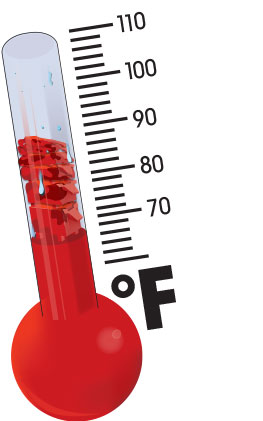Heat stress and the problems associated with it can be costly to your dairy operation. Not only are there losses in milk production, but studies are also linking heat stress to lower reproduction rates, changes in dry matter and water intake as well as increased rates of lameness.
These losses are estimated to cost the U.S. dairy market over $900 million annually.
Heat stress is defined as a situation in which high environmental temperature and humidity result in a cow’s inability to cool itself. The temperature-humidity index allows farmers to predict heat stress levels using the temperature and relative humidity of their locations.
It’s important to note the more humid an environment, the lower the ambient temperature will be at which cows get heat stressed. For instance, if a barn’s relative humidity is 20 percent, cows would be heat stressed at 75ºF, whereas at 90 percent relative humidity, cows would be heat stressed at 69ºF.

Here are some simple on-farm evaluations you can do to assess your cows for heat stress:
-
Your comfort level: If you and your staff are warm and comfortable in the barn environment, then your cows could be heat stressed. Lactating cows are more comfortable in colder environments; your first indicator should always be the ambient temperature of your facility.
-
Increased respiratory rate: Counting the breathing rates of your animals is a simple yet effective way to gauge the heat stress level throughout your facility. If a cow’s core body is at 102ºF or below, the normal respiratory rate will be around 60 breaths per minute.
As the cow’s core body temperature increases, their breathing rate will increase as well. A breathing rate of 70 or more indicates the cow is likely in a heat stress period. Taking the average respiratory rate of a handful of animals in a pen can give you a good indication of the heat stress level for that area of your barn.
-
Reduced feed intake: The more a cow eats, the more internal heat she produces. In situations of heat stress, cows reduce their feed intake which reduces the amount of heat that needs to dissipate. If cows lower their feed intake by 10 percent or more, then heat stress is affecting your herd.
-
Reduced milk production: If milk production drops by more than 5 pounds per cow during a warm weather period, heat stress may be an issue for your facility.
-
Increased standing time: An increased amount of time standing will lead to decreased milk production. Prolonged standing can also lead to an increase in lameness and other foot-related issues. It is noted cattle will be more likely to stand if their core body temperature is above 102ºF. Watching for an increase in standing time can be a simple way to notice if your animals are in heat stress.
- Grouping behavior: When cows are warm, they bunch together away from sidewalls and end walls or near water. Cows will often seek shade or find the cooler areas of the barn. If you notice most of your cows are gathered in one portion of your barn, your cows may be telling you they are in heat stress.
When looking for these visual indicators, it’s important to remember: Once you see the signs of heat stress on your farm, it’s too late to prevent heat stress from having an effect on your herd. Being proactive in keeping your cows cool is the only way to effectively prevent heat stress and protect the health and productivity of your herd.
Unfortunately, the impacts of heat stress on cows can be long-lasting, and the effects will be felt long after the heat of summer has passed.
In a 16-day heat stress test, researchers exposed dairy cows to a three-day thermoneutral phase, then five days of heat stress conditions followed by a seven-day recovery period. Feed intake began to drop at the beginning of the heat stress period but didn’t reach its peak until day four of the recovery period. Milk production did not drop until day one of the recovery period and was still compromised at the end of the study.
In another longer study using 10 years of records, it was found cows conceived in summer months and exposed to heat stress in utero had lower milk production than cows conceived in winter months, with the difference between heat-stressed and thermoneutral cows ranging from 180 pounds to 880 pounds per lactation.
Studies by the University of Florida indicate heat stress in the 45 days prior to calving resulted in lower birthweights when compared to cows who were cooled using fans or soakers in that same time frame. The effects didn’t end there; data from five consecutive summers showed maternal heat stress affected the milk production in heifers.
On average, heifers born from heat-stressed mothers produced 11 pounds less milk each day than those born from well-cooled dams.
Heat stress is not something to be taken lightly. The effects on your herd and your bottom line are long-lasting. Although the damage of heat stress is visible during the summer months, the effects will be felt for months and possibly years later.
Preventative cooling measures are the key to your long-term success. ![]()
ILLUSTRATION: Illustration by Corey Lewis.
References omitted but are available upon request. Click here to email an editor.

-
Dan Veeneman
- Artex Barn Solutions
- Email Dan Veeneman






